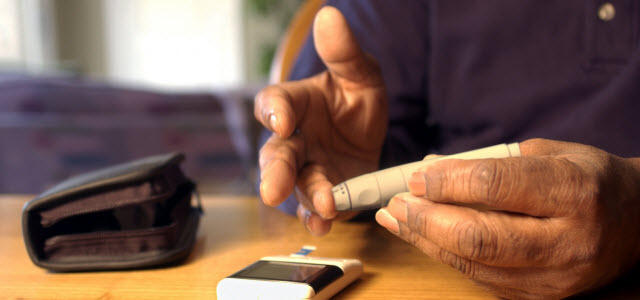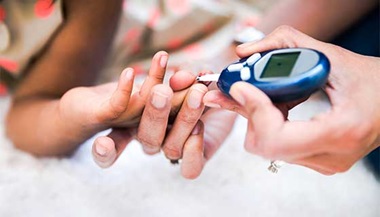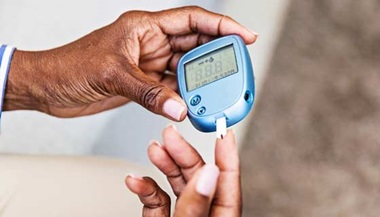Diabetes: What You Need to Know as You Age
Reviewed By:
Overview
Diabetes is a problem that has many consequences: If you have the disease, your body can no longer keep its blood sugar at a healthy level. But over time, the effects of diabetes can become much more complicated. The disease can lead to serious, even life-threatening problems from your head to your toes.
Too much blood sugar (also called glucose) can damage the blood vessels and nerves that run throughout your body. This can set the stage for many other medical conditions:
- stroke
- heart disease
- kidney disease
- vision problems and blindness
- damage to the feet or legs
However, there is good news for the 26 million Americans with diabetes—and
those at risk. Experts are learning more all the time about lifestyle steps
for diabetes control and prevention. New medications and devices can also
help you keep control over your blood sugar and prevent complications, says
Johns Hopkins expert
Rita Kalyani, M.D.
 [No text in field]
[No text in field]
Prevention
Though type 1 diabetes usually develops in childhood or early adulthood, it can develop later in life. However, it’s not currently known what the exact risk factors are or how to prevent it.
Women can lower their risk of gestational diabetes by staying active and keeping a healthy weight before they ever get pregnant, particularly if they have other risk factors for diabetes.
The form of diabetes you can do a lot to prevent is type 2 diabetes. Usually, people first develop prediabetes before they go on to have full-blown type 2 diabetes. If you know that you have prediabetes, making changes to your lifestyle is an important way to keep from developing diabetes, Kalyani says. Talk to your doctor about some ways to reduce risk:
Lose (even a little) weight. The Diabetes Prevention Program, a large-scale study of diabetes prevention strategies in those at high risk for type 2 diabetes, found that participants who engaged in 30 minutes of physical activity daily and lost at least 7 percent of their body weight cut their risk of getting type 2 diabetes by 58 percent. How it works: Losing excess pounds through proper diet and exercise can improve the body’s ability to use insulin and to process glucose more efficiently.
Move more. To maintain an active lifestyle and reduce risk of diabetes, aim for at least two and a half hours of exercise each week. You don’t have to work out hard—even brisk walking can help, says Kalyani.
Enjoy a healthy diet. Develop an eating plan that helps you lose weight and keep it off. You may want to work with a dietitian to learn healthy eating habits that you can follow long-term. Some smart steps: focusing on produce, whole grains , and lean protein , and cutting back on fat and red meat.
Try medical interventions. You may need to take medication to lower your chances of developing diabetes, especially if lifestyle changes aren’t helping enough, Kalyani states. A drug that doctors often recommend in these cases for persons with prediabetes is metformin. It can help you better control your blood sugar by reducing the amount of glucose that your liver makes.
Diagnosis
Common symptoms of type 1 and type 2 diabetes include:
- unusual thirst or hunger
- frequent urination
- fatigue
- blurry vision
- weight loss
However, some people with diabetes don’t always notice symptoms, particularly in the early stages.
At one time, being tested for prediabetes or diabetes took a little more work: A health care provider took a sample of your blood, and you had to either go without eating for eight hours or swallow a heavily sweetened drink made for diabetes testing. However, the newer test doesn’t require any special preparation. The hemoglobin A1C test measures how much glucose has attached to red blood cells in your blood. This provides a view of your blood sugar levels over the past three months. An A1C of 5.7 percent to 6.4 percent is classified as prediabetes; 6.5 percent or higher is diabetes.
Treatment
People with type 1 diabetes need to treat it with regular injections of insulin. People with type 2 diabetes can sometimes manage it with insulin injections, non-insulin injections, pills, diet and/or exercise.
If you develop diabetes, your main task is still to keep your blood sugar under control. But you also have a new goal: preventing complications. Here’s how to use the many methods that are available to stay at your best health.
Prevent complications. Heart disease and stroke are the top causes of death among people with type 2 diabetes. To lower your risk of these threats and other complications, your doctor might make these recommendations:
- Lose weight.
- Stop smoking.
- Take aspirin regularly if you are at high risk.
- Use medications to control high blood pressure or unhealthy cholesterol.
- Keep your feet in good condition. Even small blisters or other small injuries on your feet can grow into serious problems.
Find the right medications. Different non-insulin drugs lower your blood sugar by different actions:
- They may encourage your pancreas to make more insulin.
- They can help your body respond better to insulin.
- They may mimic the action of a substance in your body called GLP-1, which lowers your blood sugar after meals.
Your doctor may suggest that you start taking just one medication, then add more options over time if you can’t get your blood sugar under control. However, if your A1C level—a measure of your long-term blood sugar—is especially high when you’re diagnosed, your doctor may suggest that you start taking more than one medication to control your blood sugar right away.
You may also need to start using injections of insulin to control your type 2 diabetes right after you’re diagnosed. Even if you don’t have to take it right away, most people with type 2 diabetes eventually need to start using insulin, Kalyani says. But don’t consider the need to start insulin a failure or setback—diabetes is a disease that can change over time and require new treatment approaches. Starting insulin can help you better manage your diabetes and lower your risk of complications.
Track your blood sugar. Your doctor may want you to regularly check your blood sugar and report the results. Ask your doctor or pharmacist to recommend a blood sugar monitor that is easy for you to use. Some have backlighting and large numbers so you can see the results more easily, Kalyani says, and some store multiple readings over time so you can just download the results at your doctor’s office.
Keep your blood sugar from going too low. Some diabetes medications can cause your blood sugar to drop too low. This problem is called hypoglycemia, and it can be serious. Know how to recognize the symptoms of hypoglycemia (such as shakiness, sweating, and confusion) and talk to your doctor about how to treat it.
Learn more about the symptoms, diagnosis and treatment of diabetes in the Health Library.
Living With...
“With proper self-management and good education, people with diabetes can live long, healthy lives,” Kalyani says. “If well-controlled, it should not detract from their quality of life but will require some adjustments to their daily routine.”
However, diabetes is a chronic disease that isn’t curable. You’ll need to control it for the rest of your life, which will require time, attention, and good choices. Here are a few steps you can take to enjoy a healthy life with type 2 diabetes.
Stick to your medication plan. One reason people may not control their diabetes well is because they don’t take their medications as directed. You may have many reasons that you are not taking your medicines properly:
- They have side effects.
- You have to take a complicated array of many drugs.
- You forget when it’s time to take a dose.
- They cost too much.
- You don’t like reminders that you have diabetes.
- You’re not feeling any symptoms.
Talk to your doctor if these issues—or any others—are keeping you from taking your medications properly. Your doctor may be able to help you find solutions.
Build a team of medical partners. You’ll probably need to regularly check in with a variety of health care providers to make sure you’re controlling your diabetes and lowering your chances of complications:
- a primary care provider
- an endocrinologist (a doctor who specializes in diabetes, usually referred by your primary care provider)
- a pharmacist
- a diabetes educator
- an eye care provider to make sure your eyes are healthy and to treat any diabetes-related vision problems
- a podiatrist to check your feet and prevent minor problems from becoming serious
Don’t forget about your lifestyle changes. Even if you’re on one or more medications, it’s still important to eat right, exercise regularly, and watch your weight.
Research
Johns Hopkins experts are always striving to understand more about diabetes, its complications, and new methods for control and prevention. Some notable research to check out:
Diabetes increases women’s heart disease risk. Recently, Kalyani and her colleagues at Johns Hopkins studied how diabetes affects women’s risk of heart disease. They included men and women under the age of 60. Among people without diabetes, men were much more likely to develop heart disease than women. But once women developed diabetes, their risk increased by four times and to the same level as the men who had diabetes—in other words, the risk of heart disease by sex became equal.
Many with diabetes are not taking steps to preserve vision. Despite recent advances in prevention and treatment of most vision loss attributed to diabetes, a Johns Hopkins study found that fewer than half of Americans with eye damage from diabetes were aware of the link between the disease and visual impairment, and only six in 10 had their eyes fully examined in the year leading up to the study.
For Caregivers
“Caregivers are very important for helping people manage their diabetes,” Kalyani says. “We always encourage family members to be actively involved.” If you have a loved one with diabetes, you may be able to assist with certain tasks:
Prepare healthy meals. Make and shop for foods that don’t cause the person’s blood sugar to surge.
Encourage exercise. Invite your loved one with diabetes to get moving with you, such as on walks and with other physical activities.
Remember and remind. Help the person remember when to take medications and remind him to do blood sugar checks on the proper schedule.
Keep watch. Be on the lookout for symptoms of diabetes-related complications.
Attend checkups. Accompany your loved one on regular doctor visits.
Definitions
A1C Test: A blood test used to diagnose and monitor diabetes. By measuring how much glucose (also called blood sugar) is attached to the oxygen-carrying protein in your red blood cells, this test gives you and your health-care provider a picture of your average blood glucose levels over three months. A normal result is below 5.7 percent. If you have type 2 diabetes, you should have this test done twice a year to check if your blood glucose is under control.
Blood glucose: Also referred to as blood sugar, the primary energy source for the cells in your body. Blood glucose levels rise after meals and fall the longer you’ve gone without eating. Your blood glucose level is a measure of how much glucose you have in your bloodstream. A normal fasting blood glucose level is between 70 and 100 mg/dl (milligrams per deciliter of blood).
Insulin (in-suh-lin): A hormone made by the cells in your pancreas. Insulin helps your body store the glucose (sugar) from your meals. If you have diabetes and your pancreas is unable to make enough of this hormone, you may be prescribed medicines to help your liver make more or make your muscles more sensitive to the available insulin. If these medicines are not enough, you may be prescribed insulin shots.
Lean protein: Meats and other protein-rich foods low in saturated fat. These include boneless skinless chicken and turkey, extra-lean ground beef, beans, fat-free yogurt, seafood, tofu, tempeh and lean cuts of red meat, such as round steaks and roasts, top loin and top sirloin. Choosing these can help control cholesterol.
Prediabetes: When blood glucose (also called blood sugar) levels are higher than normal and not yet high enough to be diagnosed with diabetes. That’s an A1C of 5.7 percent to 6.4 percent (a way to estimate your 3-month average blood sugar reading), a fasting blood glucose level of 100 to 125 mg/dl, or an OGTT (oral glucose tolerance test) two hour blood glucose of 140 to 199 mg/dl. Prediabetes is also sometimes called impaired glucose tolerance or impaired fasting glucose.
Whole grains: Grains such as whole wheat, brown rice and barley still have their fiber-rich outer shell, called the bran, and inner germ. It provides vitamins, minerals and good fats. Choosing whole grain side dishes, cereals, breads and more may lower the risk for heart disease, type 2 diabetes and cancer and improve digestion, too.





